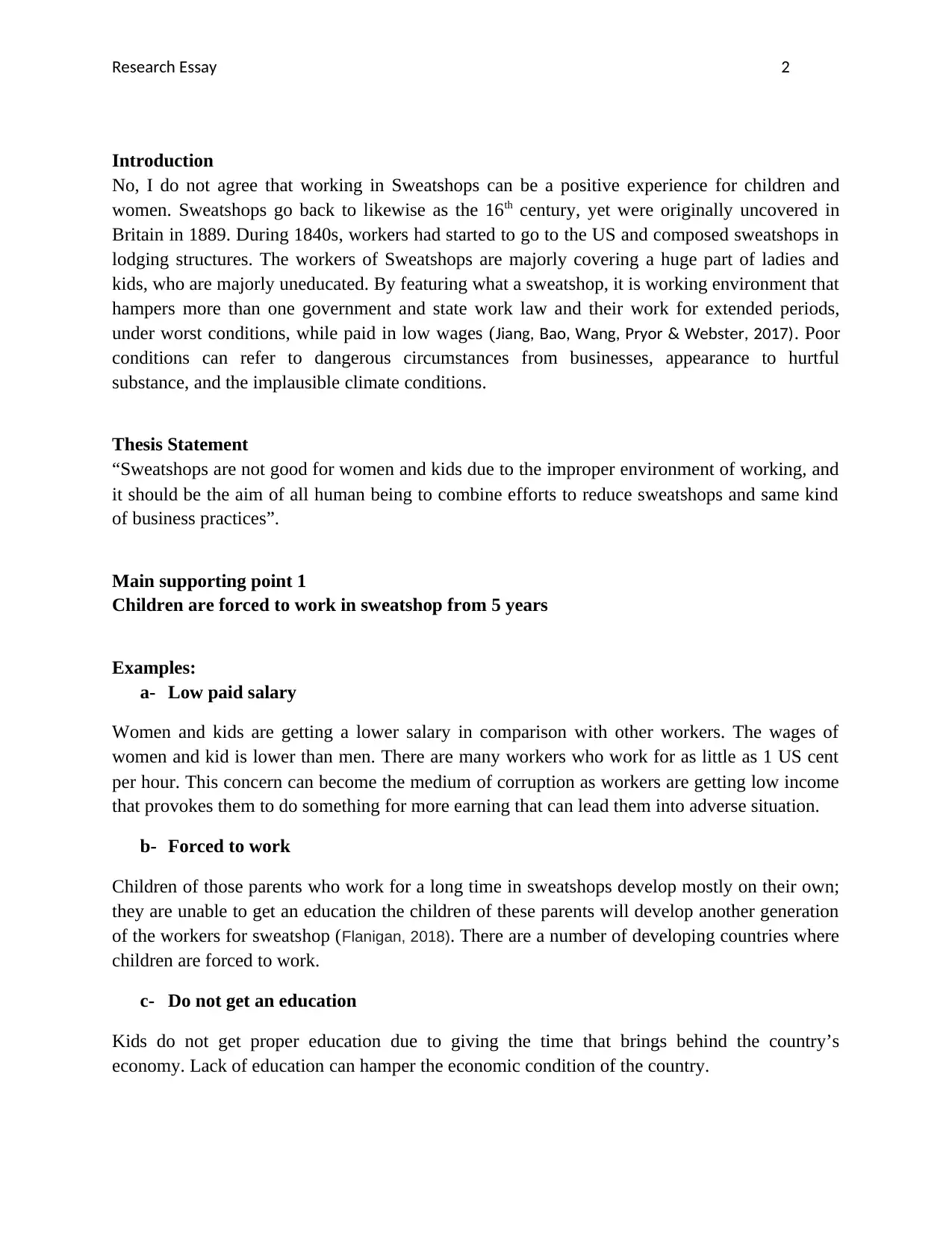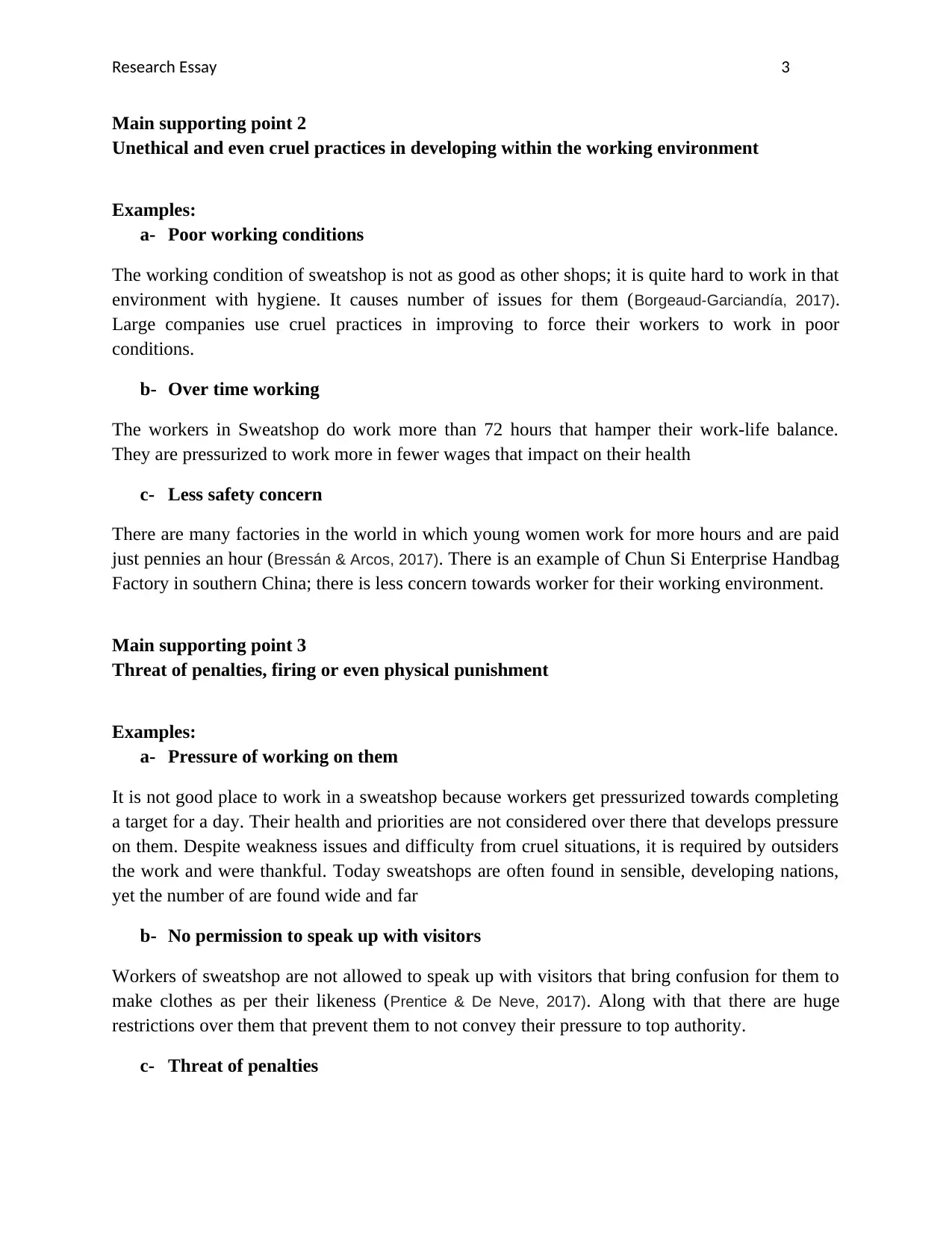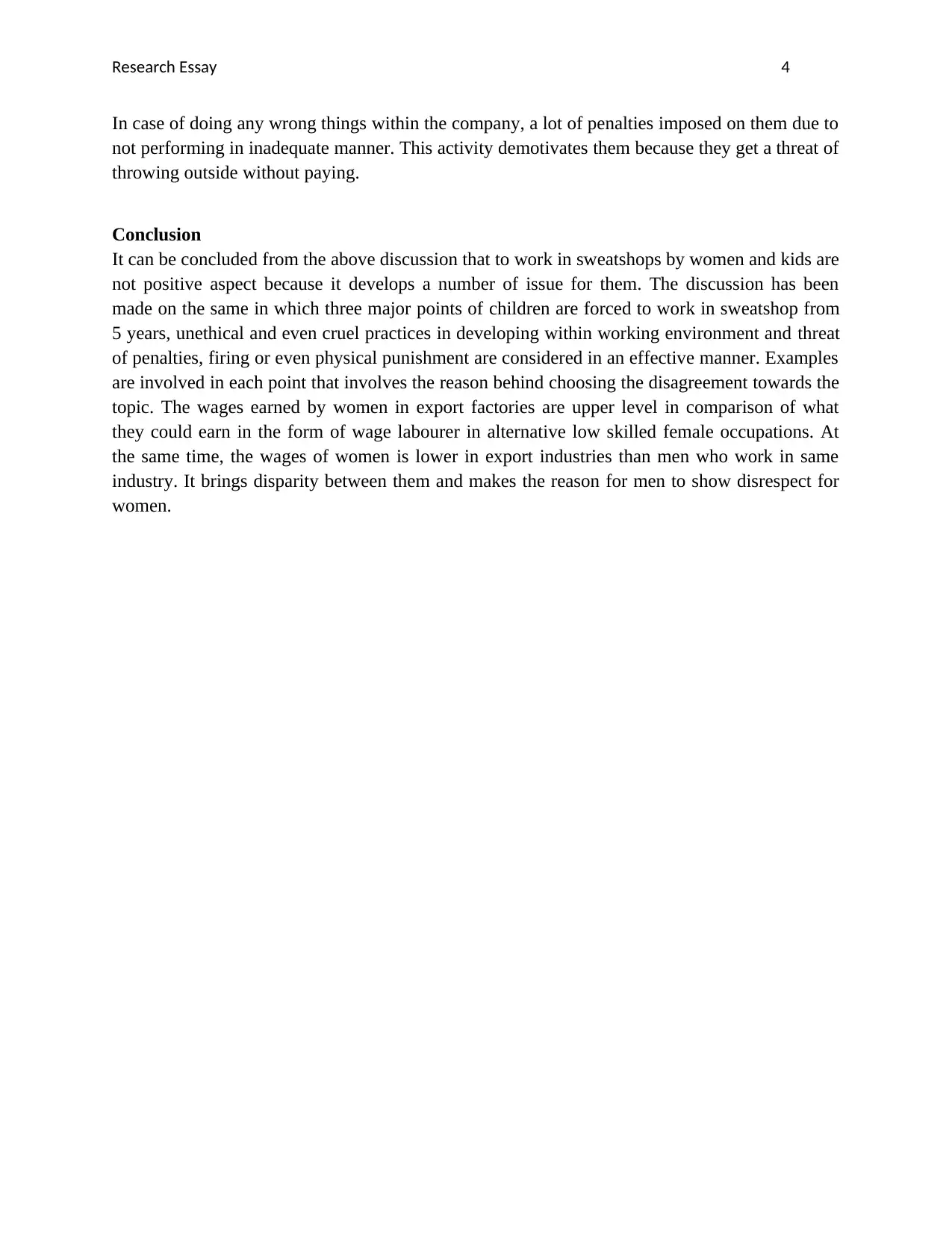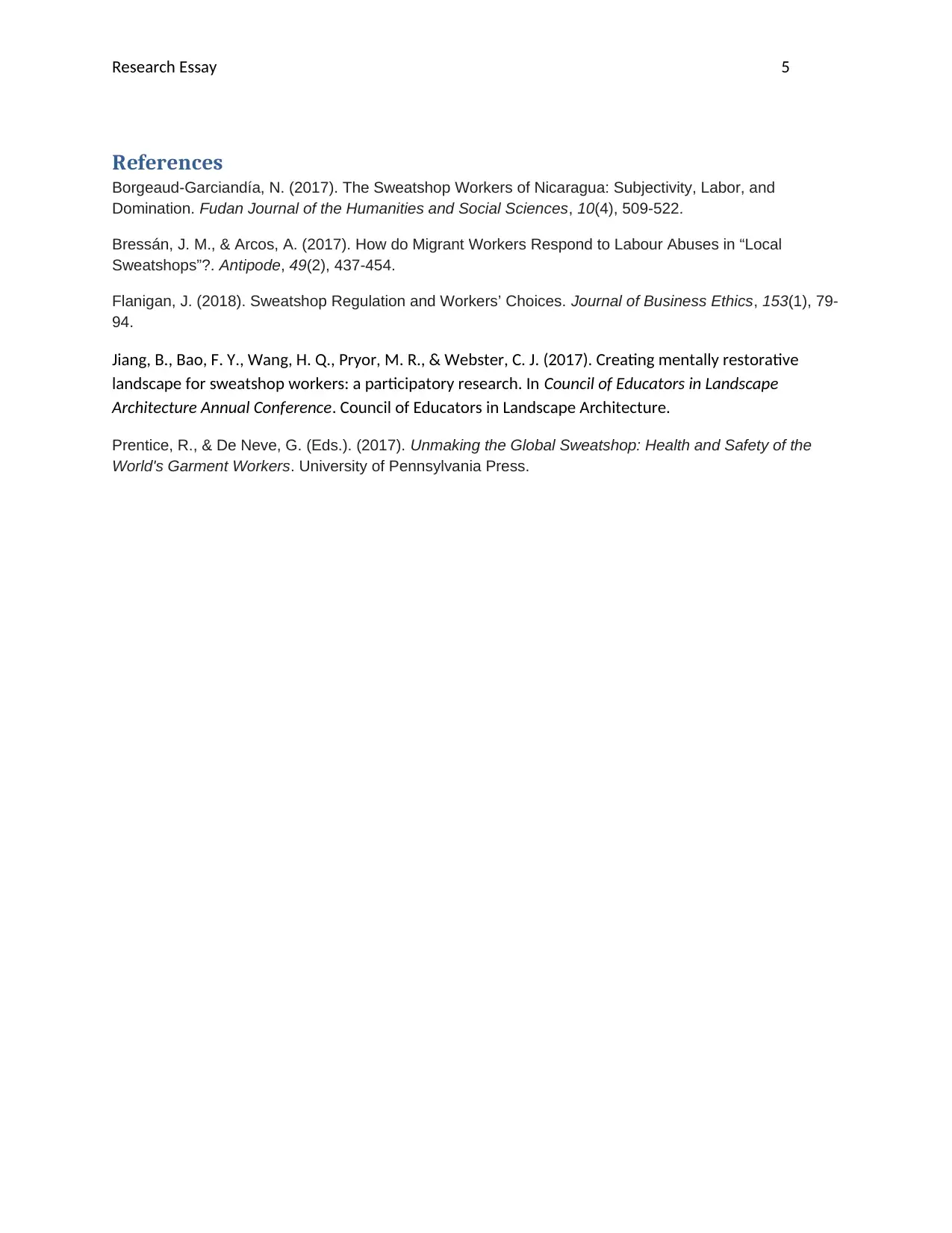Sweatshops: Negative Impact on Women and Children
VerifiedAdded on 2023/01/11
|6
|1151
|56
AI Summary
This research essay discusses the negative impact of sweatshops on women and children. It explores the issues of low wages, poor working conditions, and threats of penalties. Examples are provided to support the arguments.
Contribute Materials
Your contribution can guide someone’s learning journey. Share your
documents today.

Research Essay 1
Documented Research Essay Assignment
Documented Research Essay Assignment
Secure Best Marks with AI Grader
Need help grading? Try our AI Grader for instant feedback on your assignments.

Research Essay 2
Introduction
No, I do not agree that working in Sweatshops can be a positive experience for children and
women. Sweatshops go back to likewise as the 16th century, yet were originally uncovered in
Britain in 1889. During 1840s, workers had started to go to the US and composed sweatshops in
lodging structures. The workers of Sweatshops are majorly covering a huge part of ladies and
kids, who are majorly uneducated. By featuring what a sweatshop, it is working environment that
hampers more than one government and state work law and their work for extended periods,
under worst conditions, while paid in low wages (Jiang, Bao, Wang, Pryor & Webster, 2017). Poor
conditions can refer to dangerous circumstances from businesses, appearance to hurtful
substance, and the implausible climate conditions.
Thesis Statement
“Sweatshops are not good for women and kids due to the improper environment of working, and
it should be the aim of all human being to combine efforts to reduce sweatshops and same kind
of business practices”.
Main supporting point 1
Children are forced to work in sweatshop from 5 years
Examples:
a- Low paid salary
Women and kids are getting a lower salary in comparison with other workers. The wages of
women and kid is lower than men. There are many workers who work for as little as 1 US cent
per hour. This concern can become the medium of corruption as workers are getting low income
that provokes them to do something for more earning that can lead them into adverse situation.
b- Forced to work
Children of those parents who work for a long time in sweatshops develop mostly on their own;
they are unable to get an education the children of these parents will develop another generation
of the workers for sweatshop (Flanigan, 2018). There are a number of developing countries where
children are forced to work.
c- Do not get an education
Kids do not get proper education due to giving the time that brings behind the country’s
economy. Lack of education can hamper the economic condition of the country.
Introduction
No, I do not agree that working in Sweatshops can be a positive experience for children and
women. Sweatshops go back to likewise as the 16th century, yet were originally uncovered in
Britain in 1889. During 1840s, workers had started to go to the US and composed sweatshops in
lodging structures. The workers of Sweatshops are majorly covering a huge part of ladies and
kids, who are majorly uneducated. By featuring what a sweatshop, it is working environment that
hampers more than one government and state work law and their work for extended periods,
under worst conditions, while paid in low wages (Jiang, Bao, Wang, Pryor & Webster, 2017). Poor
conditions can refer to dangerous circumstances from businesses, appearance to hurtful
substance, and the implausible climate conditions.
Thesis Statement
“Sweatshops are not good for women and kids due to the improper environment of working, and
it should be the aim of all human being to combine efforts to reduce sweatshops and same kind
of business practices”.
Main supporting point 1
Children are forced to work in sweatshop from 5 years
Examples:
a- Low paid salary
Women and kids are getting a lower salary in comparison with other workers. The wages of
women and kid is lower than men. There are many workers who work for as little as 1 US cent
per hour. This concern can become the medium of corruption as workers are getting low income
that provokes them to do something for more earning that can lead them into adverse situation.
b- Forced to work
Children of those parents who work for a long time in sweatshops develop mostly on their own;
they are unable to get an education the children of these parents will develop another generation
of the workers for sweatshop (Flanigan, 2018). There are a number of developing countries where
children are forced to work.
c- Do not get an education
Kids do not get proper education due to giving the time that brings behind the country’s
economy. Lack of education can hamper the economic condition of the country.

Research Essay 3
Main supporting point 2
Unethical and even cruel practices in developing within the working environment
Examples:
a- Poor working conditions
The working condition of sweatshop is not as good as other shops; it is quite hard to work in that
environment with hygiene. It causes number of issues for them (Borgeaud-Garciandía, 2017).
Large companies use cruel practices in improving to force their workers to work in poor
conditions.
b- Over time working
The workers in Sweatshop do work more than 72 hours that hamper their work-life balance.
They are pressurized to work more in fewer wages that impact on their health
c- Less safety concern
There are many factories in the world in which young women work for more hours and are paid
just pennies an hour (Bressán & Arcos, 2017). There is an example of Chun Si Enterprise Handbag
Factory in southern China; there is less concern towards worker for their working environment.
Main supporting point 3
Threat of penalties, firing or even physical punishment
Examples:
a- Pressure of working on them
It is not good place to work in a sweatshop because workers get pressurized towards completing
a target for a day. Their health and priorities are not considered over there that develops pressure
on them. Despite weakness issues and difficulty from cruel situations, it is required by outsiders
the work and were thankful. Today sweatshops are often found in sensible, developing nations,
yet the number of are found wide and far
b- No permission to speak up with visitors
Workers of sweatshop are not allowed to speak up with visitors that bring confusion for them to
make clothes as per their likeness (Prentice & De Neve, 2017). Along with that there are huge
restrictions over them that prevent them to not convey their pressure to top authority.
c- Threat of penalties
Main supporting point 2
Unethical and even cruel practices in developing within the working environment
Examples:
a- Poor working conditions
The working condition of sweatshop is not as good as other shops; it is quite hard to work in that
environment with hygiene. It causes number of issues for them (Borgeaud-Garciandía, 2017).
Large companies use cruel practices in improving to force their workers to work in poor
conditions.
b- Over time working
The workers in Sweatshop do work more than 72 hours that hamper their work-life balance.
They are pressurized to work more in fewer wages that impact on their health
c- Less safety concern
There are many factories in the world in which young women work for more hours and are paid
just pennies an hour (Bressán & Arcos, 2017). There is an example of Chun Si Enterprise Handbag
Factory in southern China; there is less concern towards worker for their working environment.
Main supporting point 3
Threat of penalties, firing or even physical punishment
Examples:
a- Pressure of working on them
It is not good place to work in a sweatshop because workers get pressurized towards completing
a target for a day. Their health and priorities are not considered over there that develops pressure
on them. Despite weakness issues and difficulty from cruel situations, it is required by outsiders
the work and were thankful. Today sweatshops are often found in sensible, developing nations,
yet the number of are found wide and far
b- No permission to speak up with visitors
Workers of sweatshop are not allowed to speak up with visitors that bring confusion for them to
make clothes as per their likeness (Prentice & De Neve, 2017). Along with that there are huge
restrictions over them that prevent them to not convey their pressure to top authority.
c- Threat of penalties

Research Essay 4
In case of doing any wrong things within the company, a lot of penalties imposed on them due to
not performing in inadequate manner. This activity demotivates them because they get a threat of
throwing outside without paying.
Conclusion
It can be concluded from the above discussion that to work in sweatshops by women and kids are
not positive aspect because it develops a number of issue for them. The discussion has been
made on the same in which three major points of children are forced to work in sweatshop from
5 years, unethical and even cruel practices in developing within working environment and threat
of penalties, firing or even physical punishment are considered in an effective manner. Examples
are involved in each point that involves the reason behind choosing the disagreement towards the
topic. The wages earned by women in export factories are upper level in comparison of what
they could earn in the form of wage labourer in alternative low skilled female occupations. At
the same time, the wages of women is lower in export industries than men who work in same
industry. It brings disparity between them and makes the reason for men to show disrespect for
women.
In case of doing any wrong things within the company, a lot of penalties imposed on them due to
not performing in inadequate manner. This activity demotivates them because they get a threat of
throwing outside without paying.
Conclusion
It can be concluded from the above discussion that to work in sweatshops by women and kids are
not positive aspect because it develops a number of issue for them. The discussion has been
made on the same in which three major points of children are forced to work in sweatshop from
5 years, unethical and even cruel practices in developing within working environment and threat
of penalties, firing or even physical punishment are considered in an effective manner. Examples
are involved in each point that involves the reason behind choosing the disagreement towards the
topic. The wages earned by women in export factories are upper level in comparison of what
they could earn in the form of wage labourer in alternative low skilled female occupations. At
the same time, the wages of women is lower in export industries than men who work in same
industry. It brings disparity between them and makes the reason for men to show disrespect for
women.
Secure Best Marks with AI Grader
Need help grading? Try our AI Grader for instant feedback on your assignments.

Research Essay 5
References
Borgeaud-Garciandía, N. (2017). The Sweatshop Workers of Nicaragua: Subjectivity, Labor, and
Domination. Fudan Journal of the Humanities and Social Sciences, 10(4), 509-522.
Bressán, J. M., & Arcos, A. (2017). How do Migrant Workers Respond to Labour Abuses in “Local
Sweatshops”?. Antipode, 49(2), 437-454.
Flanigan, J. (2018). Sweatshop Regulation and Workers’ Choices. Journal of Business Ethics, 153(1), 79-
94.
Jiang, B., Bao, F. Y., Wang, H. Q., Pryor, M. R., & Webster, C. J. (2017). Creating mentally restorative
landscape for sweatshop workers: a participatory research. In Council of Educators in Landscape
Architecture Annual Conference. Council of Educators in Landscape Architecture.
Prentice, R., & De Neve, G. (Eds.). (2017). Unmaking the Global Sweatshop: Health and Safety of the
World's Garment Workers. University of Pennsylvania Press.
References
Borgeaud-Garciandía, N. (2017). The Sweatshop Workers of Nicaragua: Subjectivity, Labor, and
Domination. Fudan Journal of the Humanities and Social Sciences, 10(4), 509-522.
Bressán, J. M., & Arcos, A. (2017). How do Migrant Workers Respond to Labour Abuses in “Local
Sweatshops”?. Antipode, 49(2), 437-454.
Flanigan, J. (2018). Sweatshop Regulation and Workers’ Choices. Journal of Business Ethics, 153(1), 79-
94.
Jiang, B., Bao, F. Y., Wang, H. Q., Pryor, M. R., & Webster, C. J. (2017). Creating mentally restorative
landscape for sweatshop workers: a participatory research. In Council of Educators in Landscape
Architecture Annual Conference. Council of Educators in Landscape Architecture.
Prentice, R., & De Neve, G. (Eds.). (2017). Unmaking the Global Sweatshop: Health and Safety of the
World's Garment Workers. University of Pennsylvania Press.

Research Essay 6
1 out of 6
Related Documents
Your All-in-One AI-Powered Toolkit for Academic Success.
+13062052269
info@desklib.com
Available 24*7 on WhatsApp / Email
![[object Object]](/_next/static/media/star-bottom.7253800d.svg)
Unlock your academic potential
© 2024 | Zucol Services PVT LTD | All rights reserved.





